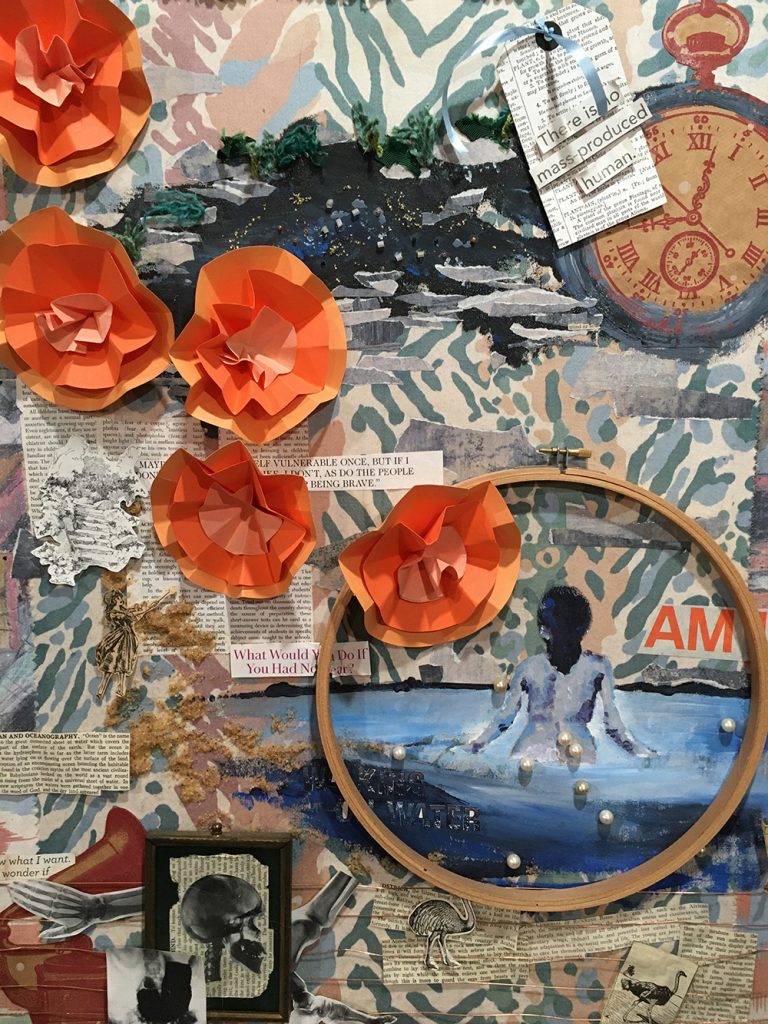In this Featured Member series, AATA celebrates the work of our members. During the coronavirus pandemic, we are inviting members to share their experiences about how their professional and personal lives have changed.
August 26, 2021
What has changed (or remained the same) in your job/studies during the COVID-19 pandemic?
The pandemic really forced me to prioritize and focus on what I am passionate about in my work as an art therapist. This ability to prioritize has allowed me to be at home with my young children and also do work that is meaningful for me. It brought me to a path where I was able to start working with individuals seeking art therapy as a support during pregnancy and postpartum. Prior to the pandemic I had imagined continuing to work with children, however, when given the opportunity to support mothers who were struggling with birth trauma and postpartum identity changes, I really started to feel at home in my work.

“Vulnerability” by Janna VanderBand. Acrylic paint, fabric, beads, and collage materials. April 20, 2016.
In what ways have your clients been impacted by COVID-19? Have you been able to continue care? How are you managing your own stress during this time?
In some ways the changes that have come with Covid-19 have really benefited my clients. The new mothers that I have worked with can now stay home in a place that they feel safe and comfortable while also receiving therapeutic support. It’s huge to not have to worry about how you’re going to feed your new baby during a session or whether they are going to have a poop blow out upon arriving to your office.
I manage my own stress by finding little, fulfilling projects to complete around my home. I love to design my space and make it my own and that’s one thing that being at home all the time during a pandemic really lends itself to. I also “read” science fiction novels via apps on my phone and have stayed connected to my faith practice.
How have race related issues, social justice, and racism informed or impacted your work as an art therapist or studies as a student?
In all of the areas in which I work, I notice the people who occupy those spaces. Many of the spaces are dominated by white people and I’ve started to examine why that it is, how I can learn more about the needs of people of color, and learn to just be there to listen to their stories. For example, I’ve listened to birth stories from women of color. Black women have higher infant mortality rates and generally worse birth outcomes than white people because of unconscious bias in medical spaces. Just being conscious of this fact and able to point in out to other providers and people in my life is part of making change.
How do you view your role as an art therapist during COVID-19?
Regardless of the state of the world, although it is very applicable during these pandemic times, I see myself as a facilitator of safe spaces. I want my clients to be able to find spaces in their lives, in their bodies, and in their births that are safe. With women who have experienced birth trauma, this can look like creating a nest out of objects that they are drawn to (fabric, yarn, paper, felt, moss, branches). This nest can then be used to craft a birth plan that outlines not only their medical preferences (epidural, no epidural, delayed cord clamping etc) but also their emotional and mental health preferences. It can also help them embody and internalize this feeling of safety through image, sensations, and the movement of creating.
Janna VanderBand, MSAT, ATR-P
 Janna is an Art Therapist in Grand Rapids, Michigan. She received her Master of Science in Art Therapy with an Emphasis in Counseling from Mount Mary University and a Bachelor of Applied Arts in Two Dimensional Art from Central Michigan University. She currently provides individual and group therapy addressing perinatal mood disorders, addiction, and other mental health needs. Prior to working in private practice and addiction treatment, Janna worked as a Family Therapist at a local residential treatment facility for children ages 7 to 17. She is the President Elect of her state chapter, the Michigan Association of Art Therapy.
Janna is an Art Therapist in Grand Rapids, Michigan. She received her Master of Science in Art Therapy with an Emphasis in Counseling from Mount Mary University and a Bachelor of Applied Arts in Two Dimensional Art from Central Michigan University. She currently provides individual and group therapy addressing perinatal mood disorders, addiction, and other mental health needs. Prior to working in private practice and addiction treatment, Janna worked as a Family Therapist at a local residential treatment facility for children ages 7 to 17. She is the President Elect of her state chapter, the Michigan Association of Art Therapy.
